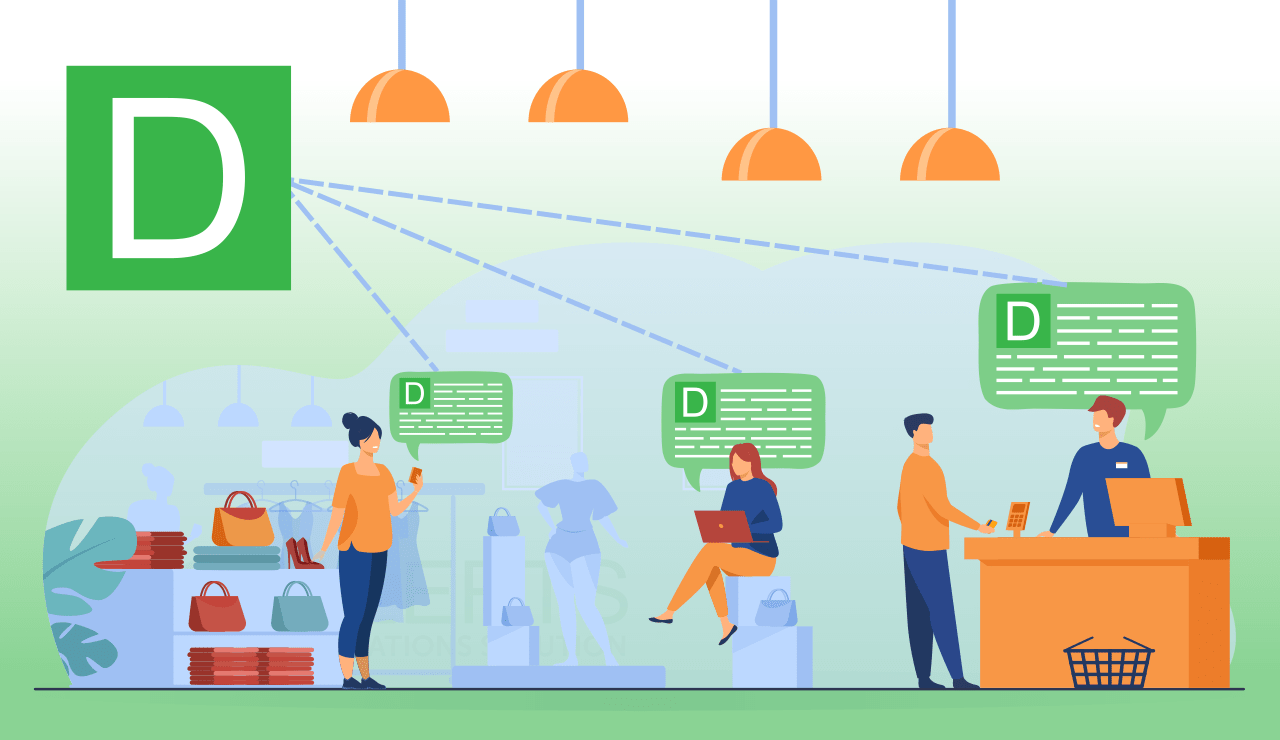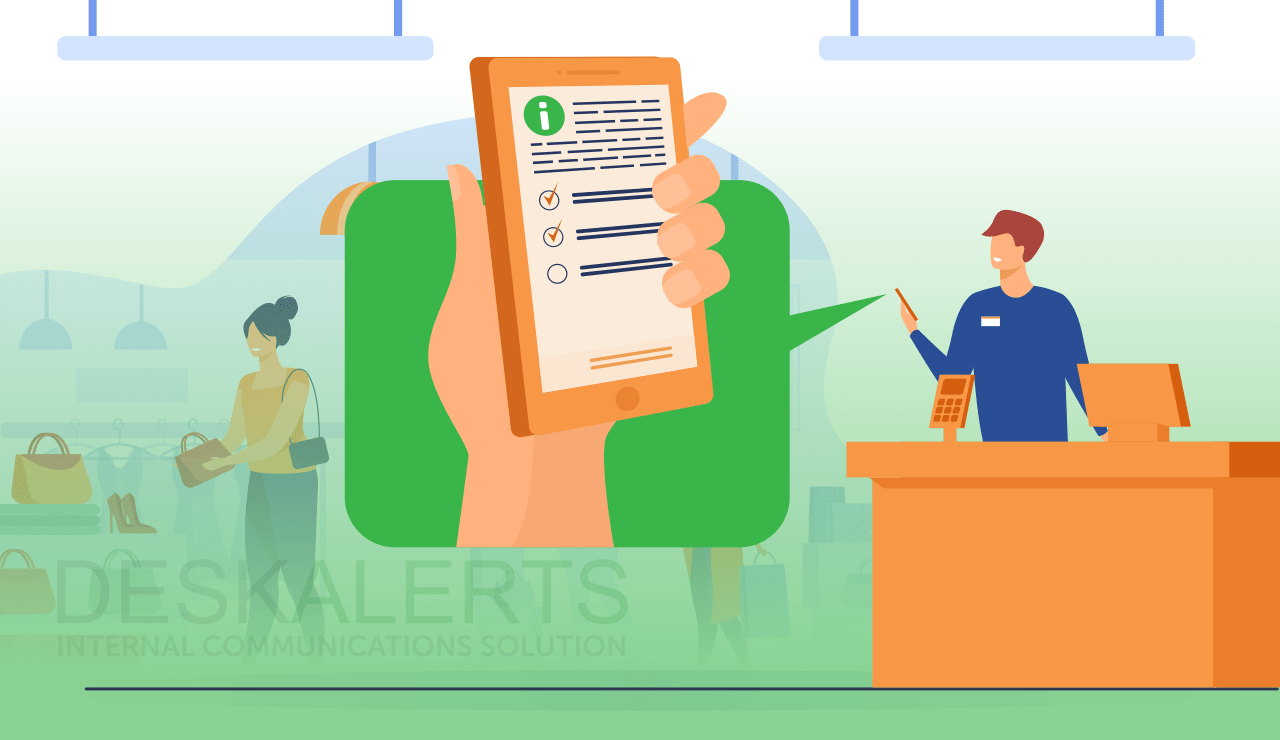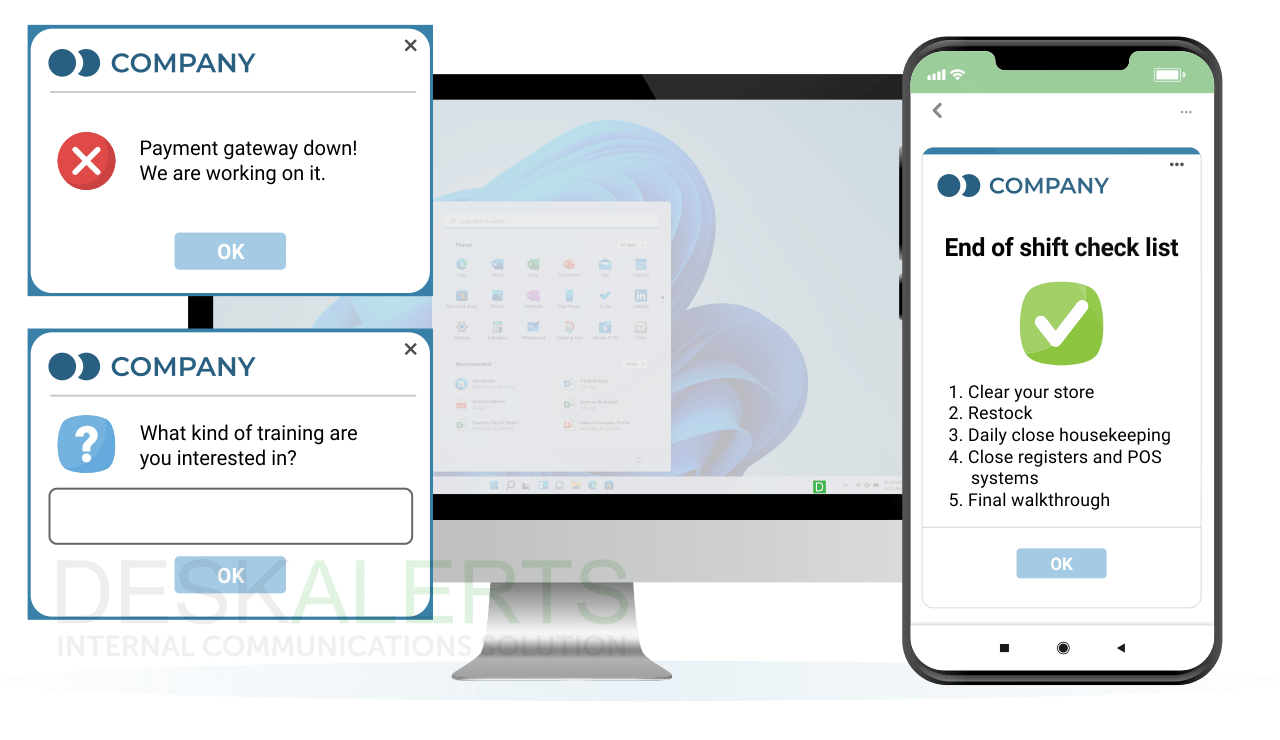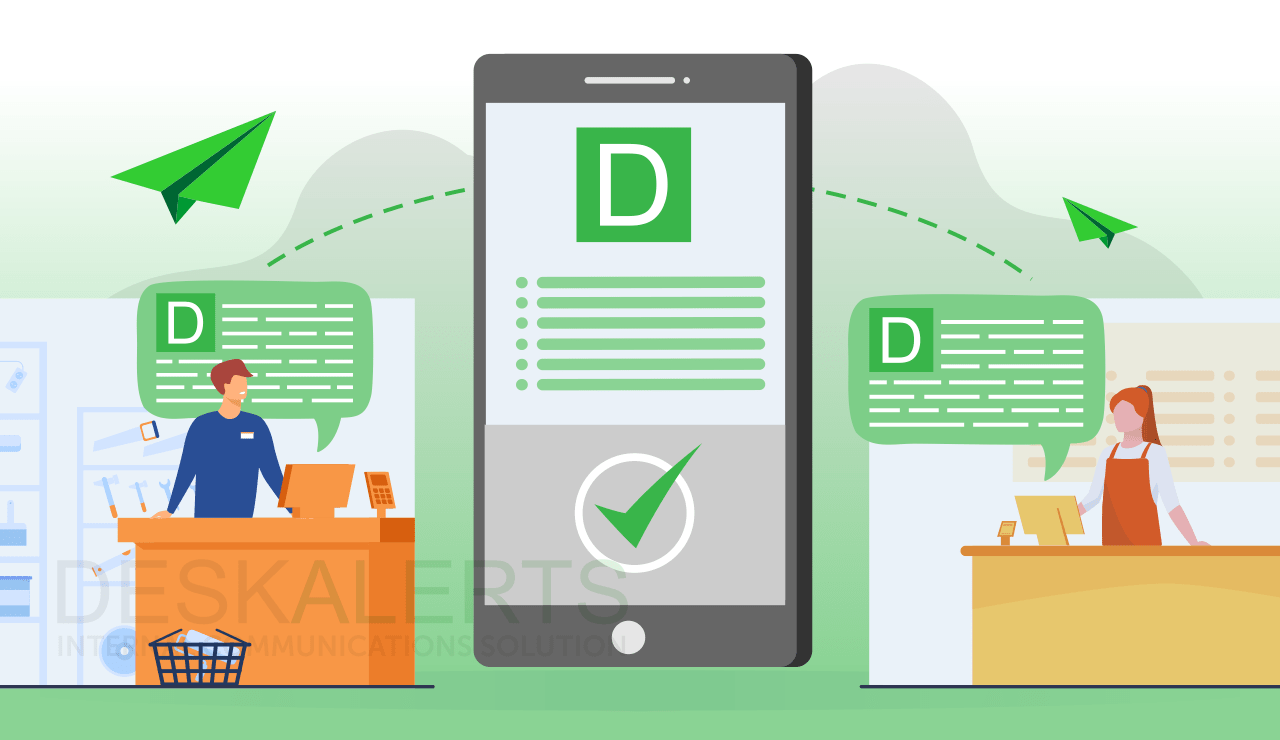 Internal communication is a challenge for many industries, and the retail sector is no different. In fact, it has its own unique challenges to overcome in this area, compared with other industries as there is a disconnect between corporate management and employees on the ground in stores and outlets.
Internal communication is a challenge for many industries, and the retail sector is no different. In fact, it has its own unique challenges to overcome in this area, compared with other industries as there is a disconnect between corporate management and employees on the ground in stores and outlets.
Table of contents
Why internal communication is important for retail
Common issues in retail internal communications
Strategies for improving retail internal communications
Types of communication in the retail sector
COVID-19 and communication in the retail environment
How DeskAlerts can help improve store communication
Sharing information is important. For management it means reaching employees to let them know what is happening within the company, preventing rumors and misinformation, and ensuring that all team members are striving to achieve common goals. For employees, it means being able to feed information to management about any issues that are occurring at the coal face so they can be addressed and improvements can be made.
It sounds straightforward, but in the retail sector, information flowing in either direction usually comes via a local manager or team leader.
A 2016 study by WorkJam found that 46% of retail companies haven’t got a direct channel of communication between their headquarters and employees on the front-line. And this isn’t very surprising - a Gatehouse study found that more than 40% of businesses say they have difficulties sharing corporate information with staff who aren’t desk-based.
These companies instead rely on the store or regional managers to inform team members about policies, procedures, new products, and promotions… and this can be a significant impediment to good store communications.
What results from this is a disconnected team working in silos at different stores across the company. If some managers are better at communicating with employees than others, then naturally those teams will be better informed while some others flounder. Similarly, managers may be reluctant to pass on feedback from employees to head office because it may reflect poorly on them. The Head office won’t have an accurate picture of what is happening in their stores.
Learn more: Retail communication examples.
Why internal communication is important for retail
Retail is a tough sector to be in these days. Around the world, even before the COVID-19 pandemic, many established and formerly successful retail brands have gone out of business in recent years for a range of complex factors around the economy, technology, and shifting consumer preferences. And because it’s already such a competitive sector, there’s little room for retailers to make mistakes.
Poor internal communication can be costly
For retailers this can include:
- Disconnected and disengaged employees who don’t have loyalty and investment in the company and desire to see it succeed.
- Higher staff turnover (which comes with its own costs).
- High rates of absenteeism and presenteeism.
- Decreased productivity.
- Sales associates who aren’t trained properly in the products or promotions on offer.
- Poor customer service - especially when a customer feels as though they have not gotten the brand experience they were expecting.
- Reduced or lost sales.
- Failure to get feedback about significant customer service issues or concerns filtered back to management.
The importance of retail communication can’t be overstated.
When retail businesses have strong internal communications practices in place they can:
- Build cohesive and strong performing teams and break down silos.
- Build a positive workplace culture.
- Share knowledge across different sites so employees don’t have to “reinvent the wheel” when trying to solve problems.
- Attract and retain employees who are committed to working for the brand.
- Develop sales associates who are passionate about the products they are selling.
- Improve sales figures - engaged employees can boost your revenue by around 18%
- Encourage innovation.
- Understand quickly when there are any issues that need to be resolved to take decisive action.
Common issues in retail internal communications
There are numerous corporate structures in the retail sector. Some brands may have only a few stores in one area, while others may have hundreds or thousands of outlets across a very large geographic area. Regardless of this, common issues with internal communications still crop up in different retail businesses.
This includes:
- Employees either don’t have access to email or share one computer.
- Stores with lots of employees working part-time, across a range of shifts, who don’t always interact with senior management or may not be rostered on when a staff meeting is held and information is shared.
- Corporate offices relying on managers to communicate with employees verbally.
- Corporate relying on flyers and posters in staff common areas to communicate with employees on the ground.
- Inconsistencies in training and onboarding new employees.
- Employees being told incorrect information and then passing that on to customers.
- Employees being frustrated at not being understood by corporate.
- Employees feeling like they are not valued members of the team.

Strategies for improving retail internal communications
Corporate communication within the retail sector needs to capture every employee - not just those who work in corporate headquarters.
The people working on the front line in your stores are the face and voice of your brand with your customers… they cannot be overlooked.
If your organization is struggling to reach all its workers with important information, there are some things you can do to turn it around:
1. Have a plan, and stick to it
If you don’t already have an retail communications strategy in place, it’s important that you have one. It will not only act as a road map to help you improve internal communications with your employees, but it will keep you accountable. Your plan should outline how and when you will communicate with employees, who will be responsible for communicating, and what you will say.
Ad hoc internal communications that aren’t strategic are never going to be effective in the same way the way that retail communication strategies are.
2. Change your company culture
Too often in organizations, not just in the retail sector, an “us vs. them” mentality can exist when employees who work in the corporate headquarters seem to be out of touch with the reality of what it is like for employees working on the organization’s front lines.
Your corporate leadership team needs to take steps to really understand what is happening at all levels of the organization. They should be visible, approachable and eager to make improvements. You can’t just expect your frontline employees to be brand ambassadors if senior management isn’t living and modeling these values as well.
>>Read more about leadership communication during COVID<<
3. Embrace digital communications
Your employees may not have access to company email, but just about every one of them will have a smartphone. An employee app lets you send important official information from the company straight to their phones.
This could be on virtually any topic, from your latest sales and marketing campaigns to HR announcements, rostering details, and IT outages and issues. You can reach people no matter where they are - whether they are at work, or not working that day.
4. Use technology to build teams
Sharing knowledge between different team members who work in different places is a good way to solve problems - especially if someone has already encountered it
before and come up with a great way to deal with it. When you have silos because of the geographic realities of different store locations and distances, it can be difficult to achieve this.
Providing a platform for your employees to discuss issues informally can help with the exchange of information. There are different ways to do this, from Slack or Teams apps through to private social media groups.
5. Ditch the posters and flyers
Preparing and sending out flyers and posters to put up in staff break rooms may seem like second nature to communicate new initiatives and promotions to staff in the retail space. However, after a while, employees may fail to notice them.
Instead of traditional paper signage, try digital signage in your break areas instead. With digital signage you can create eye-catching, colorful, moving billboards letting employees know about new promotions, products, and campaigns. Digital signage is proven to work in recall and retention in many settings.
6. Train your managers in the importance of good communication
Inconsistent approaches from management in different stores will mean that internal communications suffer, particularly if managers don’t understand or don’t value the importance of good communication with their teams. Train them in the best practices and give them the right tools to support them to prioritize communication on the ground.
7. Give employees a voice
Good internal communication is a two-way street. Giving your employees a voice can help management at corporate understand what is happening in your stores, and is a good way to capture feedback, suggestions for improvement, and identify emerging issues.
There are different ways to do this - you can issue quick surveys and polls, have anonymous feedback options, or have an “open door” policy where employees are actively encouraged to reach out to senior management.
8. Ensure consistent onboarding and training
Training is so important in the retail sector when you want your customers to have a consistent brand experience, no matter which store they visit. A uniform onboarding training package should be delivered to all employees when they start, no matter where they are, with the same key messages. When further training is required, for example in new processes or products, consistent training should also be rolled out across the company - it shouldn’t vary from store to store.
9. Recognize accomplishments
Reward and recognition programs are not only a good way to boost employee engagement and morale, but they are also a good internal communications tool. Sharing success stories will help to build your team, and also encourage collaboration.
>>Read how to deliver motivational messages to employees and get 39 free samples<<
10. Ensure consistent, clear and frequent communication
Internal communication should be consistent. Store managers shouldn’t be saying things that are at odds with what corporate management is saying. Clear communications are important so there is no room for ambiguity or interpretation, and everyone can be on the same page - no matter which store they work in. Communication should also be frequent - without it, your employees will feel as though they are in the dark.
Types of communication in the retail sector

There are two main types of communication that are used in the retail sector: the type that takes place within an organization or the type that extends outwards to communicate with customers.
1. Internal communication in retail
This relates to the way that retail organizations communicate with their staff members to ensure that they are well informed so that they can provide the best possible customer service. Poor internal communication leads to lack of direction and poor understanding and, ultimately, can harm the corporate reputation and the customer experience.
2. Communication between the store and the customer
This is the method of communication that reaches customers and in turn affects profits. Employees need to be empowered to be good communicators and also need to have access to the most up to date information about the company, products, promotions, policies and more so that the customer gets a seamless experience.
The main tools used in the retail sector to facilitate these communications include:
Corporate intranets – web pages only accessible by people within an organization
Digital signage displays – where LED and LCD screens within an organization display messages and graphics
External surveys - where customer feedback is captured about their thoughts on your brand, products, customer service etc.
Internal surveys – where employee feedback is captured
Newsletters – where people are sent news and updates.
COVID-19 and communication in the retail environment
Retail has had a lot to deal with during the COVID-19 pandemic. Reaching employees quickly with consistent information has been an essential part of the response…and sadly not every company has done it well.
I know one person who works for a large supermarket chain who found out about a COVID-19 outbreak in his store from the media (the media had been told via a corporate press release.) This was three hours before contact tracers from corporate phoned him to let him know he may have been exposed. This sort of situation is not ideal and can cause fear, misinformation, and panic.
Retailers need to have good systems in place to communicate quickly with employees in the following scenarios:
- If there has been a positive COVID-19 case in the store.
- Whether the store can open or must close under local restrictions.
- If your retail operation is deemed to be “essential”.
- How many customers can be in the store at once.
- Social distancing practices.
- Mask and glove use.
- Cleaning protocols.
- What to do if customers are aggressive about having to comply with restrictions.
- Any other measures to keep employees safe.
Communicating with employees should be the number one priority before communicating with the media, customers, and other stakeholders.
How DeskAlerts can help improve store communication
DeskAlerts is a software system that lets you get information to your employees quickly, no matter where they are in the world.
Whether you have multiple retail stores based in one city or spread out across the globe, our system can reach them quickly with the press of a button. Messages can be sent to any screen in the organization - from desktops and laptops in the corporate headquarters to the computer screens and digital screens in your stores.
Features include:
Frequently asked questions
What is effective communication at retail?
Effective communication in retail is the type of communication that has positive outcomes for both employees and customers.
What are 5 strategies to improve communication?
The five main strategies to improve communication include:
- Providing employees with undivided attention
- Taking the time to listen to employees
- Being aware of how you are communicating and how it may be perceived
- Following up verbal interactions with written communication
- Aim to be both informative and inspiring
Why is communication important in the retail industry?
Communication is important for the retail industry as it ensures that teams have the most relevant, recent, correct information so that they can meet and exceed customer expectations. This will improve customer satisfaction and loyalty and improve trust in your brand.
 Caroline Duncan
Caroline Duncan
 Internal communication is a challenge for many industries, and the retail sector is no different. In fact, it has its own unique challenges to overcome in this area, compared with other industries as there is a disconnect between corporate management and employees on the ground in stores and outlets.
Internal communication is a challenge for many industries, and the retail sector is no different. In fact, it has its own unique challenges to overcome in this area, compared with other industries as there is a disconnect between corporate management and employees on the ground in stores and outlets.








